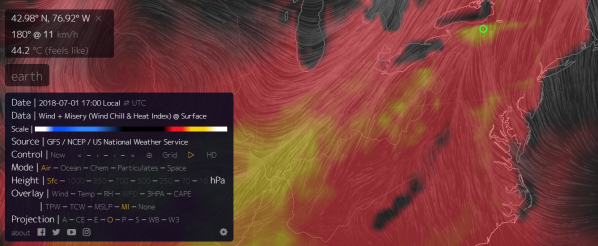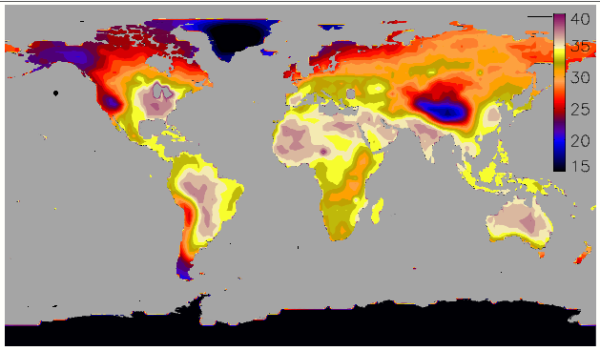This
guy says:
“At
10 C global warming, large regions of the world are regularly
predicted to experience temperatures above 35 C Wet Bulb readings”
We
are, at present at 1+ degrees C and already experiencing this. Why
does he contradict his own evidence? What is he on?!
Western Heat Predicted to Move East
27
June, 2018
The
extreme heat that is helping to fan severe western wildfires
from California to Alaska is
predicted to move eastward over the coming days.
This shift is
expected to set
off high temperatures in the 90s and 100s from
the Gulf Coast all the way to the Great Lakes and into the Northeast.
Heat Index values, meanwhile, are predicted to spike into the 100s
and 110s from the Mississippi Valley north and eastward.
(Much
warmer than normal temperatures spread from west to east across the
U.S.)
These
much warmer than normal temperatures and potentially dangerous heat
index values occur in a context of
larger national and global warming.
May of 2018 was the hottest on record according
to NOAA.
The U.S. presently sits between two
warmer to much warmer than normal ocean zones.
And overall global temperatures have been rising since the 1900s,
with a more rapid up-ramp occurring since the late 1990s.
For
the Central and Eastern U.S., warmer
than normal oceans are also spiking atmospheric moisture
levels through
increased rates of evaporation. These higher moisture levels will be
contributing to predicted heat indexes where large regions are
expected to experience temperatures that feel like the 100s or 110s
(see image below).
(Heat
index values are predicted to rise to between 40 and 45 C for large
parts of the Central and Eastern U.S. The 44 C predicted heat index
for parts of Western New York on July 1 corresponds to a 111 F ‘feels
like’ condition for this Northeastern region. Such high heat index
values present a heightened risk of heat injury due to long term
exposure. Image source: Earth
Nullschool.)
Combined
high heat and humidity increase the risk of heat injury due to
exposure. And rising heat indexes and
wet bulb temperatures are
just one of the many potentially harmful aspects of human caused
climate change.
In the future, parts of the world will become so hot and humid that healthy adults sitting in the shade will die within a matter of hours. It’s hard to imagine, and yet that’s where Earth’s climate is headed, perhaps sooner than expected.
But
while many recent studies have rightly focused on physical human
limits under high
wet bulb temperature risks for parts of South Asia and
the Middle East, the Central to Eastern U.S. is also a region of
concern. Climate risks to this region of the U.S. are due to both
high predicted temperatures and high moisture levels from
increasingly warm Gulf and Atlantic Ocean surfaces. The result is
that heat capable of resulting in rapid heat injury or even loss of
life, with wet bulb temperatures above 35 C, is possible by
mid-to-late Century under high fossil fuel burning scenarios.
(At
10 C global warming (sic), large regions of the world are regularly
predicted to experience temperatures above 35 C Wet Bulb readings —
or a level at which the human body is not naturally capable of
cooling itself. Of course, such dangerous Wet Bulb readings are
possible under still lower levels of global warming. Note that the
Central to Eastern U.S. is one of the indicated hot spots from
this recent paper.)
Though
the Eastern U.S. is not yet facing extreme wet bulb readings of this
kind, temperatures and humidity levels are presently on the rise. So
the predicted heat wave is still expected to pack a punch. And
perhaps a bit more than we’re used to.
We’re
looking at a predicted extended period of significant above normal
temperatures and high humidity over the coming days. So the public
should stay tuned to local media for heat advisories issued by the
National Weather Service (see
heat safety tips here)
and do what they can to keep cool by drinking water frequently and by
spending less time exposed to blazing temperatures and sweltering
humidity.





On what? On the faith that electric cars will turn the tide.
ReplyDeletegeoengineeringwatch.org Educate yourself.
ReplyDelete